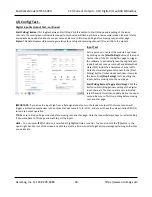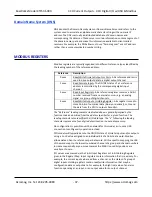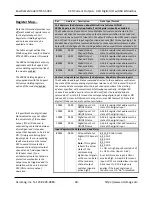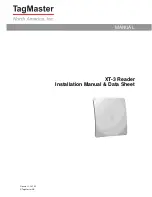
BusWorks Model XT1531‐000
4 CH Current 4 CH Digital I/O w/USB & Modbus
Acromag, Inc. Tel: 248‐295‐0880
‐
31
‐
i2o Mapping…
The four input channels of this device may be mapped to four output channels at another Acromag digital I/O module at
one or two different IP addresses. Subsequent messages will be sent at a periodic rate specified by update time. Note
that the target output channels may still be controlled independently via the network, but their state will be overwritten
by subsequent mapped messages when enabled. It is recommended that you do not control the i2o targeted mapped
output channels directly, as this could create contention with i2o control. You cannot use the USB software to control the
state of outputs that are i2o targets.
[Get i2o Config] Button:
Click this button to retrieve the current i2o configuration from the unit. See the Status field for
the status of this operation.
Target IP Address 1 & Target IP Address 2:
This is the IP Address of a group of 4 output channels at one or two target
output modules (other compatible modules on the network). The four digital inputs of this unit can only be mapped to a
group of four digital outputs (in same order) at one or two target IP addresses.
Holding Register Address 1 & 2:
This is the Memory Map address of the output channels (4 consecutive digital output
channels) at your i2o target to send this units input data to.
Update Time Field:
Specify a time from 5‐65534 seconds between messages. Specify 0 or 65535 to turn i2o messaging
O
FF (cyclical). If change‐of‐state is enabled and a time greater than or equal to 5 is specified, your message will be sent
both upon change of state and at the update time specified.
Change‐of‐State Checkbox
:
Set ON to enable output updates on change of input state, and OFF to update cyclically
according to the update time.
Keep Target Sockets Open Checkbox:
Check this box to keep the communication socket of the target device open after
sending i2o data to it. Keeping the socket open is helpful to obtain faster throughput, as open and close socket messages
are not required for each i2o message, allowing an i2o message to be sent immediately along an already open socket. But
you should not keep the socket open if you do not require frequent updates, as it does limit the bandwidth somewhat. So
for wireless/cellular systems, or peer‐to‐peer applications with long intervals between update messages, you may
consider unchecking this box. While still possible, do not Keep Sockets Open and set update intervals greater than 99
seconds (infrequent messaging with long i2o intervals does not need to keep the socket open).
Status Field (USB):
Gives the status of your USB i2o configuration message (i.e. returns the status of the write or read of
i2o configuration info only).
[Send i2o Config] Button:
Click this button to write your i2o configuration to the unit. You may click
[Send i2o Config]
for
each group, one at a time, or you can step through all i20 channels and then click the
[Send i2o Config]
button one time
to write your entire i2o configuration. See the Status field for the status of this operation.















































